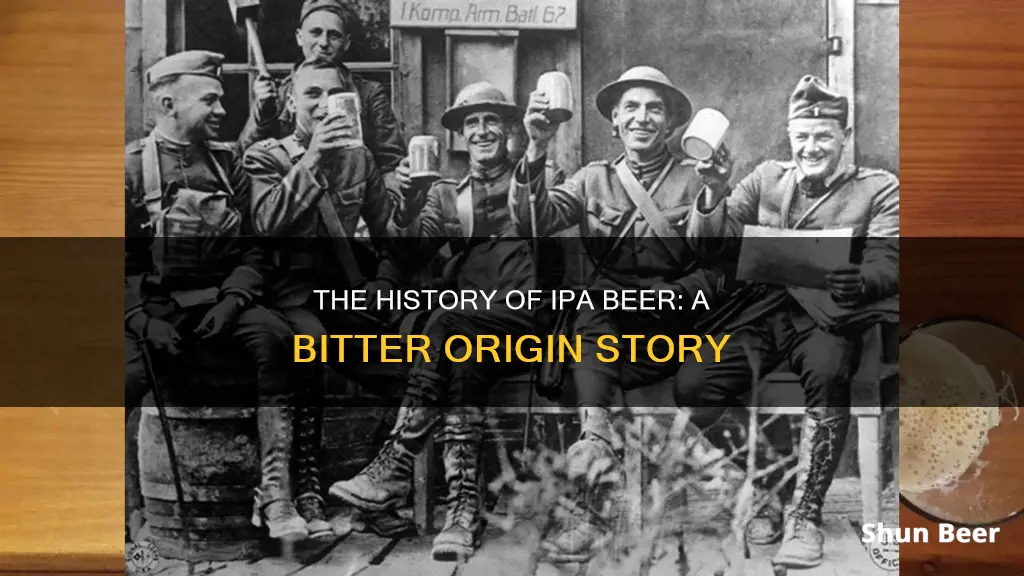
India Pale Ale (IPA) is a hoppy beer style within the broader category of pale ale. The name India Pale Ale originates from the beer's history as an export beer shipped to India, which was under the control of the British East India Company until 1858. The beer was originally brewed in England and was made with enough hops to preserve it during its long voyage from England to India. The style has since evolved and branched out into many different sub-styles, with the modern approach focusing on exploring the world of fruity flavours that can be derived from hops.
| Characteristics | Values |
|---|---|
| Name | India Pale Ale (IPA) |
| Origin | England |
| History | IPAs were originally export beers shipped to India, which was under the control of the British East India Company until 1858. |
| History | Early IPAs were brewed with extra hops and alcohol to preserve them during the long voyage from England to India. |
| History | IPAs gained popularity in England around 1840 and became one of the country's best-selling beers. |
| ABV | Typically higher than other pale ales, with an average of 6%. |
| Style | Hoppy, bitter, and with fruity or citrus notes. |
| Sub-styles | Session IPA, Standard IPA, Double IPA, NEIPA (New England IPA), Belgian IPA, Milkshake IPA, Sour IPA, etc. |
What You'll Learn

IPAs were originally exported to India
IPAs, or India Pale Ales, were originally exported to India in the late 18th century. The beer was shipped to India, which was under the control of the British East India Company until 1858.
One of the first brewers known to export beer to India was George Hodgson of the Bow Brewery in East London. Hodgson's beer became popular among East India Company traders as it was located just two miles from the East India Docks, and Hodgson offered a liberal credit line of 18 months. The beer was packed with extra hops and an increased alcohol content, which helped to preserve it during its long sea journey from England to India.
Hodgson's beer was a strong, pale beer called barley wine or "October beer." It was brewed with just-picked hops, which gave it a longer shelf life and helped it survive the voyage to India. The beer was well-received in India, as it was more refreshing than the dark ales and porters that were popular in London.
Other breweries soon followed Hodgson's lead, including Allsopp's brewery, which developed a strongly-hopped pale ale in the style of Hodgson's for export to India. Burton-upon-Trent brewers, including Bass and Salt, also began exporting beer to India, taking advantage of the local water in brewing their beers.
By the 1860s, India Pale Ales were widely brewed in England and had become a popular product. The term "India Pale Ale" was first used in 1835, and by the 1840s, IPAs had become one of England's best-selling beers.
Guinness Beer in Hawaii: Where to Find It
You may want to see also

The name 'India Pale Ale'
The name India Pale Ale (IPA) is derived from the beer's origins as an export beer shipped from England to India in the 18th and 19th centuries. India was under the control of the British East India Company until 1858, and British soldiers and traders in India had a taste for beer from back home. However, the long voyage and warm temperatures often caused the beer to spoil, go flat, or leak.
George Hodgson's Bow Brewery in East London is credited with creating the first IPA. Hodgson's beer, including a strong, pale ale called "October beer", was packed with extra hops and alcohol to help preserve it during the journey to India. The beer's higher alcohol content and bitterness made it more refreshing in the hot Indian climate compared to the dark ales typically consumed in London at the time.
The first known recorded mention of the phrase "India Pale Ale" was in 1835 in the Liverpool Mercury. By the 1840s, IPAs had become one of England's best-selling beers, and their popularity continued to grow in the following decades.
Today, the name IPA is used more broadly to refer to a style of hoppy beer within the broader category of pale ales. While the original IPAs were only slightly higher in alcohol content than other beers, modern IPAs are known for having a higher ABV, typically around 6%.
Guinness Beer: Organic or Not?
You may want to see also

The evolution of the IPA
The India Pale Ale (IPA) has evolved continuously since its inception, with new varieties and sub-styles emerging over time. The evolution of the IPA has been influenced by various factors, including technology, economics, agriculture, and changing consumer preferences. Here is an overview of its evolution:
1800s – Burton IPAs:
The original IPAs were brewed in Burton-on-Trent, England, and were characterised by their use of high-sulfate water from the region. These early IPAs were dry, bitter, and strong, with "India" being more of a marketing term than an indication of the beer's origin.
1950s – Mid-Century Modern:
During this period, the "Burtonization" of water allowed IPA brewing to spread beyond Burton-on-Trent to other parts of Great Britain. However, due to ingredient rationing, taxation changes, and other factors, the original gravity, hopping rate, and aging time of IPAs gradually decreased, resulting in a lower ABV and a style closer to what we now know as a bitter.
1970s – American Originals:
American craft brewers in the 1970s began experimenting with IPA recipes, substituting American ingredients, particularly Cascade hops, which imparted a grapefruity flavour. This marked the birth of American IPAs, with slightly higher ABVs than their British counterparts.
1990s – 90s Kid IPA:
With the release of more aromatic American hop varieties, such as Chinook, Centennial, and Columbus, brewers created IPAs with bolder flavours and aromas while maintaining a similar ABV range as the previous decade's American Originals.
2000s – West Coast IPA:
The early 2000s saw a focus on increasing IBUs (International Bitterness Units) in IPAs, with breweries competing to create the bitterest brew. New hop varieties like Simcoe®, Amarillo®, and Citra® were introduced, and the West Coast IPA was born, known for its strong hop character.
2010s – New England IPA:
The New England IPA, or NEIPA, marked a shift away from bitterness and towards a focus on fresh hop aroma and fruitiness. These beers are often hazy or cloudy and have extremely low bitterness, emphasising juice-like citrus flavours instead.
Present – Milkshake IPA:
The latest evolution of the IPA involves adding lactose or maltodextrin to boost the final gravity, resulting in a rounded mouthfeel and a dull sweetness that complements the fruity flavours of the hops. This style may also include additions of fruit and vanilla to create a smoothie-like or milkshake-like experience.
Throughout its evolution, the IPA has remained a popular and dynamic style of beer, with brewers constantly experimenting and creating new variations to meet the changing tastes of craft beer enthusiasts.
Guinness Beer Tanks: What's the Perfect Container?
You may want to see also

Different types of IPA
India Pale Ale, or IPA, is a hoppy beer style within the broader category of pale ale. The name dates back to the British Empire and their colonies, when the beer was exported to India. The preservative oils in hops kept the brew fresh during the voyage from England to British colonies in India in the 18th century.
Today, there are many different types of IPAs, each with its own unique characteristics. Here are some of the most common types:
British IPA
The original style of IPA, British IPAs are hoppy golden ales that use exclusively British hops like fuggles and goldings, giving them a grassy, earthy, and light citrus character. They typically have an ABV of 6-7% and are dry and bitter.
West Coast IPA
Invented in California, West Coast IPAs are inspired by British IPAs but use American hops such as Cascade, Citra, and Chinook. This gives them a piney aroma with citrus and earthy notes. They tend to be less dry due to the use of crystal malt but are significantly more bitter.
East Coast IPA
A relatively new style, East Coast IPAs differ from West Coast IPAs in the type of yeast used. East Coast brewers use mutated, complex British yeasts that produce stone fruit, banana, and tropical notes. This allows them to use fewer hops, resulting in a less bitter, cloudier, and hazier beer.
Double or Imperial IPA
Also known as Imperial IPAs, these beers were created in response to drinkers' desire for more hops. Brewers added more malt to balance the increased bitterness, resulting in a higher alcohol content. Double IPAs typically have an ABV of 7.5% or higher and feature strong hop flavours with floral, piney, and citrus notes.
Session IPA
Session IPAs are designed for casual drinkers who want a lighter beer that can be enjoyed in multiple servings or "sessions". They have a strong hoppy aroma but are less bitter, with an ABV that typically stays below 5%.
Black IPA
Also known as a Cascadian Dark Ale, Black IPAs are brewed to look like a stout but have the hoppy aroma of a typical IPA. The use of dark malts lends roasted flavours that contrast with the floral, citrus, and piney flavours of the hops. When done well, it creates a unique and delicious drinking experience.
New England IPA
Also known as Hazy IPAs, these are currently one of the most popular styles of IPAs. They are unfiltered, resulting in a hazy appearance, and have low bitterness due to the use of hop blends that lend intense fruity flavours. New England IPAs often have lower carbonation and are known for their fruit-forward flavours and aromas.
These are just a few of the many types of IPAs available today. With craft brewers constantly innovating, the world of IPAs continues to expand and delight beer enthusiasts worldwide.
Guinness Beer's Carb Content: A Detailed Breakdown
You may want to see also

The IPA glass
German glassmaker Spiegelau has collaborated with two renowned IPA breweries, Dogfish Head and Sierra Nevada, to create a glass specifically designed to enhance the aromatics and mouthfeel of an IPA. Another German company, Rastal, produces the Teku glass, which is also ideal for savouring your chosen IPA. The Teku glass is similar in design to a tulip glass, with a long stem that prevents your hand from warming the beer.
For those who prefer their IPA straight from the can, it is worth noting that pouring the beer into a glass releases all those lovely hop aromas.
Guinness and Breastfeeding: To Pump or Not?
You may want to see also
Frequently asked questions
India Pale Ale (IPA) was originally an export beer shipped to India, which was under the control of the British East India Company until 1858. The beer was formulated to survive long voyages by sea.
The popular origin story is that in the late 18th century, George Hodgson, a brewer at the Bow Brewery in East London, began sending his pale ale to India packed with extra hops and an increased alcohol content. Both the hops and the high alcohol content helped to preserve the beer during its long sea journey from England to India.
IPA is a hoppy beer within the broader Pale Ale category. It usually has a higher ABV than other pale ales.







